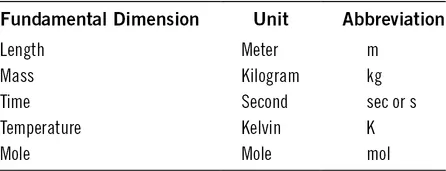
eBook - ePub
Basic Transport Phenomena in Biomedical Engineering
Ronald L. Fournier
This is a test
Buch teilen
- 654 Seiten
- English
- ePUB (handyfreundlich)
- Über iOS und Android verfügbar
eBook - ePub
Basic Transport Phenomena in Biomedical Engineering
Ronald L. Fournier
Angaben zum Buch
Buchvorschau
Inhaltsverzeichnis
Quellenangaben
Über dieses Buch
- Presents a basic understanding and the theories of transport in biological systems
- Uses real-world applications in the development and design of artificial organs, drug delivery systems, and tissues
- Contributes numerous examples throughout the text with a strong discussion of the numerical methods used
- Updates each chapter with the latest research developments
- Incorporates new problems and selected complete solutions where appropriate
Häufig gestellte Fragen
Wie kann ich mein Abo kündigen?
Gehe einfach zum Kontobereich in den Einstellungen und klicke auf „Abo kündigen“ – ganz einfach. Nachdem du gekündigt hast, bleibt deine Mitgliedschaft für den verbleibenden Abozeitraum, den du bereits bezahlt hast, aktiv. Mehr Informationen hier.
(Wie) Kann ich Bücher herunterladen?
Derzeit stehen all unsere auf Mobilgeräte reagierenden ePub-Bücher zum Download über die App zur Verfügung. Die meisten unserer PDFs stehen ebenfalls zum Download bereit; wir arbeiten daran, auch die übrigen PDFs zum Download anzubieten, bei denen dies aktuell noch nicht möglich ist. Weitere Informationen hier.
Welcher Unterschied besteht bei den Preisen zwischen den Aboplänen?
Mit beiden Aboplänen erhältst du vollen Zugang zur Bibliothek und allen Funktionen von Perlego. Die einzigen Unterschiede bestehen im Preis und dem Abozeitraum: Mit dem Jahresabo sparst du auf 12 Monate gerechnet im Vergleich zum Monatsabo rund 30 %.
Was ist Perlego?
Wir sind ein Online-Abodienst für Lehrbücher, bei dem du für weniger als den Preis eines einzelnen Buches pro Monat Zugang zu einer ganzen Online-Bibliothek erhältst. Mit über 1 Million Büchern zu über 1.000 verschiedenen Themen haben wir bestimmt alles, was du brauchst! Weitere Informationen hier.
Unterstützt Perlego Text-zu-Sprache?
Achte auf das Symbol zum Vorlesen in deinem nächsten Buch, um zu sehen, ob du es dir auch anhören kannst. Bei diesem Tool wird dir Text laut vorgelesen, wobei der Text beim Vorlesen auch grafisch hervorgehoben wird. Du kannst das Vorlesen jederzeit anhalten, beschleunigen und verlangsamen. Weitere Informationen hier.
Ist Basic Transport Phenomena in Biomedical Engineering als Online-PDF/ePub verfügbar?
Ja, du hast Zugang zu Basic Transport Phenomena in Biomedical Engineering von Ronald L. Fournier im PDF- und/oder ePub-Format sowie zu anderen beliebten Büchern aus Medicina & Biotecnologia in medicina. Aus unserem Katalog stehen dir über 1 Million Bücher zur Verfügung.
Information
Chapter 1Introduction
Before we can begin our study of biomedical engineering transport phenomena, let us first review some basic concepts that are essential for understanding the material in this book. You may have come across some of this material in other courses such as in chemistry, physics, and perhaps thermodynamics. Reviewing these concepts once again is still very important since these concepts form the basis of our approach to analyzing and solving biomedical engineering problems.
1.1Review of units and dimensions
1.1.1Units
Careful attention must be given to units and dimensions when solving engineering problems; otherwise, serious errors can occur in your calculations.
Units are how we describe the size or amount of a dimension. For example, a second is a common unit that is used for the dimension of time. In this book, we use primarily the International System of Units, which is also known by its abbreviation SI, for Système international d'unités. Other systems of units are also used, such as the English and American engineering systems and the centimeter-gram-second (cgs) system. We will come across some of these non-SI units as well in our study. The units of these other systems may be related to the SI units by appropriate conversion factors. Table 1.1 provides a convenient summary of common conversion factors that relate these other units to the SI system.
Table 1.1 Conversion Factors

It is important to remember that in engineering calculations you must always attach units to the numbers that arise in your calculations, unless they are already unitless. Furthermore, within a calculation, it is important to use a consistent system of units, and in this book we recommend that you work with the SI system. In the event that a number has a non-SI unit, you will first need to convert those units into SI units using the conversion factors found in Table 1.1. Also, remember to treat the units associated with a number as algebraic symbols. Then, as long as the units are the same, you can perform operations such as addition, subtraction, multiplication, and division on the like units, thereby combining and, in some cases, even cancelling them out.
1.1.2Fundamental dimensions
The measurement of the physical properties we are interested in are derived from the fundamental dimensions of length, mass, time, temperature, and mole. Table 1.2 summarizes the basic SI units for these fundamental dimensions. The SI unit for length is the meter (m) and that for time is the second (sec).
Table 1.2 SI Units for the Fundamental Dimensions

1.1.2.1Mass and weight
The mass of an object refers to the total amount of material that is in the object. The mass is a property of matter and is the same no matter where the object is located. For example, the mass of an object is the same on Earth, on Neptune, or if it is just floating along somewhere in space. In SI units we measure the mass of an object in kilograms (kg). Remember that the mass of an object is different than the weight of an object. Weight is the forc...